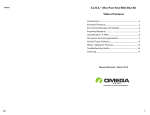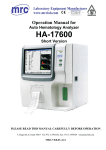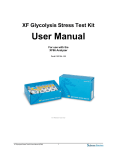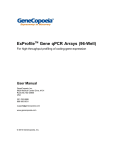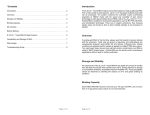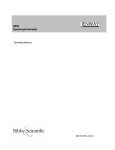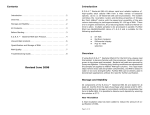Download Manual - Omega Bio-Tek
Transcript
E-Z 96 Plant RNA Kit Table of Contents Introduction....................................................................2 Illustrated Protocol..........................................................3 Kit Contents/Storage and Stability..................................4 Preparing Reagents/ Cleaning Plates............................5 Quantification of RNA......................................................6 E-Z 96 Plant RNA Spin Protocol ......................................7 Optional DNase I Digestion Protocol............................10 Troubleshooting Guide..................................................12 Ordering.........................................................................14 Manual Revision: August 2012 Innovations in nucleic acid isolation 1 Introduction The E-Z 96 Plant RNA Kit provides a convenient and rapid method for the isolation of total RNA from a variety of plant samples. The kit includes a homogenization plate to efficiently remove cell debris and simultaneously homogenize the lysate. In combination with the HiBind RNA plate, this kit permits purification of high quality RNA from as much as 40 mg seed tissue or as much as 100 mg plant tissue. The system is efficient enough to allow isolation of total RNA from as little as 0.5 mg tissue. Typical yields are shown in Table 1. E-Z 96 Plant RNA Kits are ideal for processing multiple plant samples in less than one hour. The need for organic extractions is eliminated, making total RNA isolation fast, safe and reliable. Purified RNA has Abs260/Abs280 ratios of 1.8-2.0 and is suitable for the following applications: • • • • • RT-PCR qPCR Northern Analysis Differential Analysis Poly A + RNA Selection Binding Capacity Each well of the HiBind RNA plate can bind approximately 50 μg RNA. Using more than the recommended maximum amount of plant tissue usually will not improve yields significantly and often has adverse effects. New In this Edition • • 2 The latest edition has been newly designed to enhance readability and protocol quality. 2 mL Collection Plates are now called 96-well Square-well Plates. This is a name change only, there has been no change to the plastic ware. Illustrated Centrifugation Protocol Grind and Lyse Sample Transfer Cleared Lysate to a Homogenizer Plate Adjust Binding Conditions Bind RNA and Wash 3X Dry The RNA Plate Elute 3 Kit Contents Product No. R1027-00 R1027-01 R1027-02 E-Z 96 RNA Plate 1 2 8 96-well Square-well Plate (2.2 ml)* 3 6 12* E-Z 96 Homogenizer Plate * * 1 2 8 1 x 96 2 x 96 8 x 96 5 10 40 Caps for Racked Microtubes 12 x 8 25 x 8 100 x 8 RB Buffer 55 ml 110 ml 2 x 220 ml RNA Wash Buffer I 75 ml 150 ml 2 x 300 ml RNA Wash Buffer II 35 ml 2 x 35 ml 5 x 50 ml DEPC Water 15 ml 25 ml 100 ml User Manual 1 1 1 96-well Racked Microtubes (1.2 ml) Aera Seal Film ** * 96-well Square-well Plate (2.2 ml) are reusable; see Page 5 for instructions. ** RB Buffer and RNA Wash Buffer 1 contains a chaotropic salt. Use gloves and protective eye ware when handling this solution. Storage and Stability All components of the E-Z 96 Plant RNA Kit should be stored at 22°C-25°C. Under these conditions, RNA has successfully been purified and used for RT-PCR after 24 months of storage. Under cool ambient conditions, a precipitate may form in the RB Buffer. The crystals may be dissolved by heating the buffer at 37°C and gently shaking its container. Store RB Buffer and all other components at room temperature. 4 Preparing Reagents • Dilute RNA Wash Buffer II with absolute ethanol (96-100%) as follows: Kit Ethanol To Be Added R1027-00 Add 140 mL absolute ethanol R1027-01 Add 140 mL absolute ethanol R1027-02 Add 200 mL absolute ethanol per bottle Note: It is not necessary to DEPC-treat the absolute ethanol before adding to Wash Buffer II. • Whenever working with RNA, always wear latex gloves to minimize RNase contamination. Change gloves frequently. Use only clean RNase-free disposable plastic pipette tips when using the supplied reagents. • During the procedure work carefully but quickly. • Under cool ambient conditions, crystals may form in RB Buffer. This is normal and the bottle may be warmed to redissolve the salt. • 2-mercaptoethanol (ß-mercaptoethanol) is key in denaturing endogenous RNases and must be added to an aliquot of RB Buffer before use. Add 10 μl of 2-mercaptoethanol per 1 ml of RB Buffer. This mixture can be stored for 1 month at room temperature. If RB Buffer is stored for more than 1 month, 2-mercaptoethanol should be added again. Cleaning of 96-Well Collection Plates If extra plates are needed, please call our customer service department for ordering information. To re-use the 96-Well collection plates, rinse them thoroughly with tap water, incubate overnight in 0.2M NaOH/1mM EDTA, rinse with distilled water and dry by air. 5 Quantification of RNA Storage of RNA Purified RNA can be stored at -20°C or -70°C (RNase-free water). Under such conditions RNA prepared with the E.Z.N.A.® Plant RNA Kit is stable for more than a year. Quantification of RNA To determine the concentration and purity of RNA, one should measure the absorbance at 260 nm and 280 nm in a spectrophotometer. 1 O.D. unit measured at 260 nm corresponds to 40μg of RNA per ml. DEPC Water is slightly acidic and can dramatically lower absorbance values. We suggest that you dilute the sample in a buffered solution (TE) for spectrophotometric analysis. The A260/A280 ratio of pure nucleic acids is 2.0, while for pure protein is approximately 0.6. Therefore, a ratio of 1.8-2.0 corresponds to 90-100% pure nucleic acid. [Phenol has a maximum absorbance at 275 nm and can interfere with absorbance readings of DNA or RNA. However, the E.Z.N.A.® Plant RNA Kit eliminates the use of phenol and avoids this problem.] RNA Quality It is highly recommended that RNA Quality be determined prior to all analysis. The quality of RNA can be best assessed by denaturing agarose gel electrophoresis and ethidium bromide staining. Two sharp bands should appear on the gel. These are the 28S and the 18S (23S and 16S for bacteria) ribosomal RNA bands. If these band appears as a smear towards lower molecular weight sized RNAs, the it is likely that your RNA has undergone major degradation during preparation, handling, or storage. Although RNA molecules less than 200 bases in length do not efficiently bind to the HiBind matrix, a third RNA band, the tRNA band, may be visible when a large amount of sample is used. Expected Yields Table 1 shows sample yields obtained using the standard protocol under normal conditions. Sample size 100 mg. Table 1 Yields obtained with E.Z.N.A.® Plant RNA Kits 6 Arabidopsis sp 30 μg Tobacco leaves 65 μg Mustard leaves 34 μg Maize 28 μg E-Z 96 Plant RNA - Spin Protocol E-Z 96 Plant RNA Protocol Note that all centrifugation steps must be carried out at room temperature. Materials to be provided by user • Centrifuge capable of 4,000 x g • Centrifuge rotor adaptor for 96-well microplates • Multichannel pipet • RNase-free filter pipette tips • Racked RNase-free 1.2 ml microtubes • 2ml 96-well deep well plate • 2-mercaptoethanol • Absolute (96%-100%) ethanol • Isopropyl alcohol (isopropanol) • Liquid nitrogen for freezing/disrupting samples • Water bath or heat block preset at 65°C • Optional: Genogrinder 2000/2010 with CryoBlock(2600) and CryoAdaptor (2650) Before Starting: • Preheat an aliquot (100 μl per sample) of DEPC Water to 65°C. • Set a Water Bath or Heat Block to 65°C Note: Use extreme caution when handling liquid nitrogen. This protocol is suitable for most fresh or frozen tissue samples allowing efficient recovery of RNA. However, due to the tremendous variation in water and polysaccharide content of plants, sample size should be limited to ≤100 mg plant tissue and ≤40 mg seed tissue. (Less starting material often results in better quality yields.) Best results are obtained with young leaves or needles. This method isolates sufficient RNA for a few tracks on a standard Northern assay, depending on the type and quality of the sample. Wearing latex disposable gloves, collect tissue in a 1.5 ml or 2 ml microfuge tube and freeze by dipping in liquid nitrogen with a pair of tweezers to fill the tube. Grind the tissue using disposable pestles (available from OBI Cat# SSI-1014-39 &1015-39) or equivalent. Alternatively, one can allow liquid nitrogen to evaporate and then store samples at -70oC for later use. Do not allow samples to thaw. Use disposable pestles only once. Alternatively, a small clean mortar and pestle can be used. Optional Homogenization Using Genogrinder 2000/2010: Add one 3-4 mm stainless steel bead to each well of a 96-well round well plate (compatiable with a Genogrinder Cryoadaptor) and the plant samples . Close the individual tubes with Cap Strips. Freeze the sample in liquid nitrogen in the CryoBlock Station(2600) and Cryoadaptor according to Manufacturer’s instructions Place the The racks or plates are fixed into clamps on a homogenizer. Homogenize for 2 Minutes at 1750 RPM. Tissue samples are disrupted and simultaneously homogenized with the shearing and crushing action of the beads. Remove the Plates from the GenoGrinder. Carefully remove the caps. Add 500 μl RB Buffer/2-mercaptoethanol per sample to the wells. Vortex the samples to disperse the clumps. Procede to Step 3. 7 E-Z 96 Plant RNA - Spin Protocol 1. 2. Add 500 μl RB Buffer/2-mercaptoethanol per sample to the wells of a 2 ml deep-well plate. Note: Add 10 μl 2-mercaptoethanol per 1 ml of RB Buffer before use. This mixture can be made and stored at room temperature for 1 month. 2-mercaptoethanol should be added again (estimate same proportion) if RB Buffer is stored for more than 1 month. Collect frozen ground plant tissue (up to 100 mg) or seed tissue (up to 30 mg) and add to a well containing RB Buffer/2-mercaptoethanol. Samples should not be allowed to thaw before adding to RB Buffer/2-mercaptoethanol. We recommend starting with 30 to 50 mg plant tissue or 12 to 20 mg seed tissue. If results obtained are satisfactory, increase amount of starting material up to maximum limits. Vortex vigorously to make sure that all clumps are dispersed. RNA cannot be effectively extracted from clumped tissue. Tip: As a guide, a 2-cm diameter leaf square weighs approximately 100 mg. 3. Centrifuge the plate at 4,000 x g for 10 minutes. 4. Pipet the lysate directly into a E-Z 96-Well Homogenizer Plate placed on top of a new 2 ml collection plate (supplied). Centrifuge at 3,500 x g for 10 min at room temperature. 5. Carefully transfer the supernatant of the flow-through fraction to a new 96-well Square-well Plate (supplied), making sure not to disturb the pellet or transfer any debris. Add 0.5 volume absolute ethanol and mix by vortexing. Keep and re-use the 2 ml collection plate for Step 6. Tip: In most cases 450 μl supernatant can easily be removed. This will require 225μl ethanol. The volume of supernatant may vary. For convenience, a fixed volume may be used. Measure the volume and add the correct amount of ethanol. 6. Apply the entire sample, including any precipitates that may form to a HiBind RNA Plate placed on top of the 96-well Square-well Plate from previous step. Seal the plate with aera seal film. Centrifuge at 4,000 x g for 5 minutes at room temperature. Discard the flow-through liquid and place the HiBind RNA Plate back on top of the collection plate. If the sample volume exceeds the well capacity, load successively and repeat this step. Note: Be sure that the lysate has passed completely through each well. If any lysate remains, repeat centrifugation for an additional 3 to 5 minutes. DNase I Digestion (OPTIONAL): This is the point to begin optional DNase I digestion. If DNase I digestion is necessary for downstream applications, go to Page 6 to complete the procedure using the Dnase I Digestion Protocol; otherwise continue with the next step. 7. 8 Add 600 μl RNA Wash Buffer I into each well of the HiBind RNA Plate. Seal the plate with aera seal film. Then centrifuge at 4,000 x g for 5 minutes. Discard the flowthrough liquid and place the HiBind RNA Plate into a New 2 mL Collection Plate. E-Z 96 Plant RNA - Spin Protocol 8. Add 700 μl RNA Wash Buffer II diluted with ethanol. Seal the plate with aera seal film and centrifuge at 4,000 x g for 5 minutes at room temperature. Discard the flowthrough and re-use the collection plate in next step. 9. Add 700 μl RNA Wash Buffer II diluted with ethanol. Seal the plate with aera seal film and centrifuge at 4,000 x g for 5 minutes at room temperature. Discard the flowthrough and re-use the collection plate in next step. . 10. Centrifuge the HiBind RNA Plate for 10 min at 4,000 x g to completely dry the HiBind matrix. 11. Elution of RNA: Place the HiBind RNA Plate on top of the 96-well Racked Microtubes (supplied). Add 100 μl of DEPC Water (supplied with kit) to each well. Make sure to add DEPC Water directly to the center of each membrane for optimal elution results. Incubate at room temperature for 1 minute. Centrifuge for 5 min at 4,000 x g to elute RNA. Note: RNA may be eluted with a greater (or lesser) volume of water. While additional elutions increase total RNA yield, the concentration will be lowered since more than 80% of RNA is recovered with the first elution. 9 Optional DNase I Digestion Protocol DNase I Digestion Protocol (Optional) Since the HiBind RNA technology eliminates most of the DNA, DNase I digestion is not necessary for most downstream applications. However, certain sensitive RNA applications might require further DNA removal. Follow the steps below for on-membrane DNase I digestion (see DNase I Digestion Set, Cat # E1091 or E1091-02 for further information). Note: DNase I is very sensitive and prone to physical denaturing; do not vortex the DNase I mixture. Mix gently by inverting the tube. Prepare the fresh DNase I digestion mixture before beginning the RNA isolation procedure. • Standard DNase buffers may not be compatible with Omega Bio-Tek’s DNase I Digestion Set. • 1. Follow the standard protocol until the samples completely pass through the HiBind RNA Plate (Steps 1-6). Then complete the procedure using the following steps: A) Add 300μl RNA Wash Buffer I to each well of the HiBind RNA Plate and centrifuge at 4,000 x g for 1 min. B) For each RNA sample, prepare the DNase I digestion mixture as follows: Buffer Volume per Prep E.Z.N.A.® DNase I Digestion Buffer 73.5µl RNase Free DNase I (20 Kunitz/µl) 1.5µl Total Volume 75µl 2. 3. 10 C) Pipet 75 μl DNase I digestion mixture directly onto the surface of the membrane in each well of the HiBind RNA Plate. Be certain to pipet the mixture directly onto each membrane, as DNA digestion might not be complete if some of the mixture is retained on the walls or the O-rings of the HiBind RNA Plate. D) Incubate at room temperature (15-30°C) for 15 minutes. Place the HiBind RNA Plate on top of a clean 96-well Square-well Plate and add 400 μl RNA Wash Buffer I. Incubate 3 minutes at room temperature. Centrifuge at 4,000 x g and discard flow-through. Re-use the collection plate. Place the HiBind RNA Plate on top of the same 96-well Square-well Plate and add 700 μl RNA Wash Buffer II diluted with ethanol. Centrifuge at 4,000 x g for 3 minutes and discard flow-through. Re-use the collection plate. Note: RNA Wash Buffer II Concentrate must be diluted with absolute ethanol before use. Refer to Page 3 or to the bottle label for directions. Optional DNase I Digestion Protocol 4. Add 700ul of RNA Wash Buffer II diluted with ethanol. Centrifuge at 4,000 x g for 3 minutes. Discard flow-through and re-use the collection plate. 5. Centrifuge the empty HiBind RNA Plate at 4,000 x g for 10 min to completely dry the HiBind matrix. (Complete drying is critical.) 6. Elution of RNA: Place the HiBind RNA Plate on top of the 96-well Racked Microtubes (supplied). Add 100 μl of DEPC Water (supplied with kit) to each well. Make sure to add DEPC Water directly to the center of each membrane for optimal elution results. Incubate at room temperature for 1 minute. Centrifuge for 5 min at 4,000 x g to elute RNA. Alternatively, RNA may be eluted with a greater (or lesser) volume of water. While additional elutions increase total RNA yield, the concentration will be lowered since more than 80% of RNA is recovered with the first elution. Pre-heating the DEPC Water to 65°C before adding to the HiBind RNA Plate and incubating the plate for 5 min at room temperature before centrifugation may increase yields. 11 Troubleshooting Guide Please use this guide to troubleshoot any problems that may arise. For further assistance, please contact the technical support staff, toll free, at (800-832-8896). Possible Problems and Suggestions Problem Little or no RNA eluted Cause RNA remains on the Membrane Solution Repeat elution step. Pre-heat DEPC Water to 70°C prior to elution. Membrane is overloaded Reduce quantity of starting material. Problem Cause Solution Completely homogenize sample. Clogged Membrane Incomplete homogenization Increase centrifugation time. Reduce amount of starting material Problem Cause Solution Freeze starting material quickly in liquid nitrogen Starting Tissue Problems Degraded RNA Do not store tissue prior to extraction unless they are lysed first. Follow protocol closely, and work quickly. Ensure not to introduce RNase during the procedure. RNase contamination Check buffers for RNase contamination. 12 Troubleshooting Guide Problem Cause Solution Ensure RNA Wash Buffer II Concentrate has been diluted with 4 volumes of 100% ethanol as indicated on bottle. Problem in downstream applications Salt carry-over during elution 1 X RNA Wash Buffer II must be stored and used at room temperature. Repeat wash with RNA Wash Buffer II. Problem DNA contamination Problem Low Abs ratios Cause DNA contamination Cause RNA diluted in acidic buffer or water Solution Digest with RNase-free DNase. Solution DEPC Water is acidic and can dramatically lower Abs260 values. Use TE buffer to dilute RNA prior to spectrophotometric analysis. 13 Ordering Information The following components are available for purchase separately. (Call Toll Number (1-800-832-8896) Product (Size) Part Number RB Lysis Buffer (100 mL) PR026 RNA Wash Buffer (100 mL) PR030 RNA Wash Buffer II (25 mL) PR031 DEPC Water (100 mL) PR032 RNase-free DNase Set (50 preps) E1091 RNase-free DNase Set (200 preps) E-Z 96 Homogenizer Plates ( 4 x 96 ) 96-well Microplates (500 µL) E1091-02 HCR9601-02 EZ9604-01 Hibind, E.Z.N.A and MicroElute are registered trademarks of Omega Bio-tek, Inc. Qiagen®, QIAvac® and Vacman® are all trademarks of their respected companies. PCR is a patented process of Hoffman-La Roche. Use of PCR process requires a license. 14 Notes: 15 Notes: 16
















